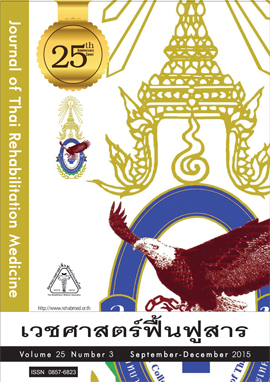ประสิทธิผลจากการใช้เครื่องกระตุ้นเส้นประสาทด้วยไฟฟ้า (ยี่ห้อเดินดี) ต่อการใช้พลังงานในการเดินของผู้ป่วยโรคหลอดเลือด สมองในระยะกึ่งเฉียบพลันที่มีปัญหาเท้าตก: การวิจัยนำร่อง
Keywords:
ผู้ป่วยโรคหลอดเลือดสมอง, อ่อนแรงครึ่งซีก, ปลายเท้าตก, เครื่องกระตุ้นเส้นประสาทด้วยไฟฟ้า, ดัชนีการใช้พลังงานทางกาย, stroke, hemiplegia, foot drop, functional electrical stimulation, physiological cost indexAbstract
Effectiveness of Functional Electrical Stimulator (FES-Dearndee™) on Physiological Cost Index in Subacute Stroke Patients with Foot Drop: a Pilot Study
Kumnoonsup S, Buntragulpoontawee M, Kovindha A
Department of Rehabilitation Medicine, Faculty of Medicine, Chiang Mai University
Objectives: To evaluate the energy-reducing effect of functional electrical stimulation (FES) -Dearndee™ in subacute stroke patients with foot drop.
Study design: Single-blinded (assessor),a pilot study (cross-over trial)
Setting: Department of Rehabilitation Medicine, Maharaj Nakorn Chiang Mai Hospital.
Subjects: Patients with subacute stroke (2 weeks – 6 months) who had foot drop during walking.
Methods: Demographic data, Brunnstrom of leg and modified Ashworth scale (MAS) of quadriceps and gastrocnemius of the subjects were collected. The subjects walked 20 meters twice, with and without FES. Heart rate and walking speed were recorded to calculate the physiological cost index (PCI, beats/m). The data were compared and analyzed with paired t-test.The relations between PCI and other factors (such as Brunnstrom of leg and MAS) were analyzed by using Spearman correlation. We also evaluated the patient’s reasons for choosing or not choosing to use FES.
Results: Ten subjects, mean age of 58.2 years old (SD 14.8), mean duration of stroke of 38.8 days (SD 38.2), were recruited. The energy cost estimated by using PCI was lower during walking with FES than without FES (mean = 0.84, 1.51 beats/min respectively; p = 0.011). There were no significant differences in heart rate and walking speed between walking with and without FES Original Articles (p = 0.741 and 0.768 respectively). The MAS of gastrocnemius had significantly positive correlation with the PCI in only walking without FES (r2 = 0.642, p = 0.046). In addition, 77.8% of all would like to continue using FES as it made them walk better.
Conclusion: The function electrical stimulation-Dearndee™ has a tendency to decrease the energy cost during walking in subacute stroke patients with foot drop.
บทคัดย่อ
วัตถุประสงค์: เพื่อวัดประสิทธิผลจากการใช้เครื่องกระตุ้นเส้น ประสาทด้วยไฟฟ้า (ยี่ห้อเดินดี) ต่อการใช้พลังงานในการเดิน ของผู้ป่วยโรคหลอดเลือดสมองในระยะกึ่งเฉียบพลันที่มีปัญหาเท้าตก
รูปแบบการวิจัย: การวิจัยนำร่องแบบสองระยะไขว้กันและ ปิดบังผู้ประเมิน
สถานที่การทำวิจัย: ห้องตรวจผู้ป่วยนอกเวชศาสตร์ฟื้นฟู โรงพยาบาลมหาราชนครเชียงใหม่
กลุ่มประชากร: ผู้ป่วยโรคหลอดเลือดสมองในระยะกึ่งเฉียบ พลัน (2 สัปดาห์ – 6 เดือน) ที่มีปัญหาปลายเท้าตกขณะเดิน
วิธีการศึกษา: เก็บข้อมูลพื้นฐานและระดับการฟื้นกำลังกล้าม เนื้อขาอิง Brunnstrom motor recovery และภาวะกล้ามเนื้อ หดเกร็งโดยใช้ modified Ashworth scale (MAS) ของกล้าม เนื้อเหยียดเข่าและกล้ามเนื้อน่องผู้เข้าร่วมการวิจัยเดินระยะ ทาง 20 เมตรสองครั้ง โดยใช้และไม่ใช้เครื่องเดินดี และวัดอัตรา หัวใจเต้นและอัตราเร็วการเดินเพื่อนำมาคำนวณหาดัชนีการใช้ พลังงานทางกายด้วย (physiological cost index, PCI) หน่วย เป็นครั้งต่อเมตร และเปรียบเทียบข้อมูลโดยใช้ paired t-test, หา ความสัมพันธ์ระหว่างค่า PCI กับตัวแปรเช่น ระดับ Brunnstrom,MAS) ด้วย Spearman correlation รวมทั้งหาเหตุผลที่ผู้เข้าร่วม งานวิจัยเลือกหรือไม่เลือกใช้เครื่องเดินดี
ผลการศึกษา: ผู้เข้าร่วมการศึกษา 10 คน มีอายุเฉลี่ย 58.2 ปี (ส่วนเบี่ยงเบนมาตรฐาน 14.8) และเป็นมานานเฉลี่ย 38.8 วัน (ส่วนเบี่ยงเบนมาตรฐาน 38.2) ขณะเดินโดยใช้เครื่องเดินดีพบ ค่า PCI ต่ำกว่าขณะเดินโดยไม่ใช้เครื่องเดินดีอย่างมีนัยสำคัญ ทางสถิติ (ค่าเฉลี่ย = 0.84, 1.51 ครั้งต่อเมตร; p = 0.011) ทั้งนี้ อัตราหัวใจเต้นและอัตราเร็วการเดินของทั้งสองกลุ่ม ไม่ แตกต่างกัน (p = 0.741 และ 0.768 ตามลำดับ) ส่วนระดับ การเกร็งของกล้ามเนื้อน่องมีความสัมพันธ์เชิงบวกกับพลังงานใน การเดินเฉพาะเมื่อไม่ใช้เครื่องเดินดี (r2 = 0.642, p = 0.046) ผู้เข้าร่วมงานวิจัยร้อยละ 77.8 เลือกที่ใช้เครื่องเดินดีในการฝึก ต่อไปโดยทุกคนในกลุ่มนี้เลือกใช้เพราะรู้สึกการเดินดีขึ้น
สรุป: เครื่องกระตุ้นเส้นประสาทด้วยไฟฟ้ายี่ห้อเดินดีมีแนวโน้ม สามารถช่วยลดการใช้พลังงานในการเดินสำหรับผู้ป่วยโรค หลอดเลือดสมองระยะกึ่งเฉียบพลันที่มีปัญหาเท้าตกได้






